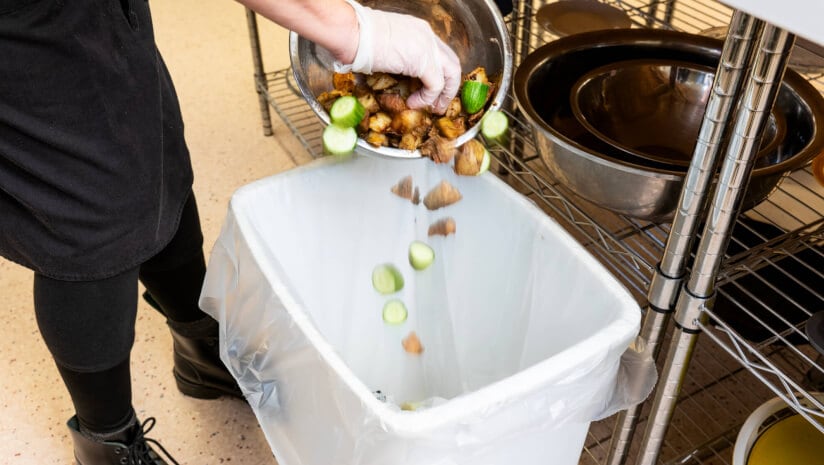Bakery is one of the largest segments of the food and drink industry. According to Circana data, the UK bakery market was worth £6.65 billion in 2024, up 1.8% year-on-year, and holds around a 6% share of the entire food market.
The sector operates on several levels, ranging from craft bakeries to industrial facilities, while it can be split across bread, rolls, cakes and pastries, among others. And like much of the rest of the F&B sector, it is heavily influenced by trends and consumer preferences.
Understanding trends
Before delving into the top trends that are influencing the type of bakery products being introduced to market, it is important to understand the processes behind trend identification and the new tools that firms are utilising.
“Bakery NPD and consumer purchasing habits are influenced by so many factors – consumer confidence through to the latest flavour or format that is trending on social media,” said Jacqui Passmore, a senior marketing lead at US bakery firm Dawn Foods.
These trends differ based on location, meaning that the innovation process must take into account local preferences as well as wider trends too. According to Passmore, bakery is often closely linked to ideas around identity, which makes understanding regional tastes very important.
She explained: “Locally, we closely partner with customers on a range of R&D projects as well working with our regulatory teams to stay ahead of country-specific legislation which may affect future product development.
“This enables us to understand what is important to our customers and the wider market, giving us valuable insight into both trends and shaping of our priorities.”
Meanwhile, Dawn has a market research and insights team that assesses macro-trends from around the world, and then uses these findings to guide the firm’s NPD teams.
“The team looks at how trends such as Covid-19, inflation and climate change, for example, impact consumer purchasing habits,” explained Passmore.
Like in all sectors of the food and drink industry, social media is playing an ever-more influential role in shaping preferences and demands. At leading bakery products supplier Baker & Baker, the team analyses all flavour concepts that go viral in order to understand their appeal and consider how they can be applied to its own products.
Tailored solutions for bakery success
Dawn Foods’ bakery ingredients include best-in-class mixes, bases, icings, glazes and fillings, as well as innovative market-driven solutions for vegan, gluten-free, longer shelf life, and reduced sugar fruit fillings.
We’re on the pulse of trends in today’s fast moving bakery sector and partner with food manufacturers to create customised finished products that excite the taste buds and are a feast for the eyes.
Our chefs and experienced bakery technical teams work with you, not just on NPD but in creating efficiencies in operations or reworking existing applications to meet specific production requirements and improving profitability.
As well as creative sweet bakery solutions, Dawn offers the support you expect and more from a global ingredients supplier. Our diverse production sites and ingredients are covered by IFS, GFSI, BRC, Halal, Kosher, Vegan certification schemes. And our dedicated regulatory teams mean manufacturers can ensure all products are compliant as well as being fully traceable throughout the supply chain.
For more information about Dawn Foods, click here.

“Social media increasingly plays a role in creating stand out appeal and driving broader awareness,” said Jonathan Adams, NPD director for Baker & Baker UK.
“[It] is also a great vehicle to attract a new and younger audience to the bakery market with content that is executed correctly.”
To speed up the insights gathering, bakery ingredients firm Puratos has started using an AI system that is capable of extracting the most important takeaways from online conversations and articles that are relevant to the industry.
“Our Taste Tomorrow ‘always-on’ insights programme allows us to track evolving consumer preferences and spot emerging taste trends across bakery, patisserie and chocolate,” said Philippa Knight, marketing director at Puratos UK.
“We know we need to look at more than one source to spot trends, so we combine this online listening with traditional quantitative and qualitative market research to gather feedback from over 20,000 consumers and experts in more than 50 countries.”
Adams agreed that online analysis and social media research alone are insufficient, and explained that Baker & Baker still engages in face-to-face meetings with suppliers and customers as a compliment to more high-tech solutions.
“It’s critical for the team to find time to get out and about, attending trade shows and events, going to the latest foodie hotspots and seeing what flavours are emerging, but not only in bakery, across the whole food and drink industry,” he said.
“It’s also important to note that not all flavours that become popular with artisanal or smaller bakeries will gain mass market appeal. There are always other considerations such as cost and relevance that sometimes prevent flavours or concepts from translating across channels.”
Like Puratos, ingredients solutions provider IFF has also built its own proprietary insights tool, a trend intelligence framework called Panoptic. According to the firm’s global product category marketing manager for bakery and food enzymes, Gwynnie Hagen, Panoptic integrates a range of considerations such as societal drivers, lifestyle trends and market insights in order to create a more complete picture of consumer preferences as they evolve.
“By analysing consumer surveys and market data, we stay ahead of global sensorial trends in ingredients, flavours, textures, and scents,” Hagen explained.
“In bakery, we have identified key lifestyle movements – Budget Consciousness, Sustainable Choices, and New Value Equation – to guide future innovations. This comprehensive approach ensures IFF remains attuned to shifting consumer needs and market dynamics.”
Flavour of the month
With the tools and methods discussed above now at the disposal of many firms in the bakery industry, flavour profiles and trends have become more exploratory and complex than in the past. This is not to say that nostalgic tastes are out, but increasingly experimental blends and previously inaccessible items are becoming desired.
At Baker & Baker, Adams explained that consumers want to see classic comfort products reinvented so that traditional flavours can be enjoyed in new ways.
“This is being driven by improving the quality or heritage of key flavours to really elevate such products that have traditionally been seen as comfort foods,” he said.
“We are also seeing a rise in foreign traditional flavours and products beginning to enter the bakery arena, the best example of this would be the rise in Middle Eastern influence more recently with the TikTok sensation around Dubai Bars, but also more mainstream, specifically with pistachio fillings and visual toppings.”
Linked to this idea of reinvention is the growing trend of savoury, sour and unconventional flavours crossing over into the sweet bakery segment.
“Miso, Umami and the use of sourdoughs are helping to give premiumisation to standard products, for example using sourdough to uplift a doughnut body paired with perhaps a Miso caramel filling,” Adams offered as an example.
“Botanicals are also becoming increasingly popular in bakery, as a new way to elevate flavours, embrace seasonality and obtain an herbaceous health boost. Elderflower dominates the scene but cherry blossom, lavender and rose are also restaurant menu favourites – particularly for summer.”
Nonetheless, he was clear that an old favourite, chocolate, remains core to most bakery categories, in spite of recent cocoa inflation.
“There remains a strong consumer affection for chocolate and we don’t expect that to change anytime soon,” Adams concluded.
Another area trend that has persisted is premium indulgence, although Cargill’s ‘Sweet Delights’ research suggests that while “indulgence remains a key purchase trigger” consumers now want the best of both worlds. This means tasty products with an improved nutritional profile, an energy boost without the sugar crash, and portion control.
“The rise of both the premium indulgence and guilt free consumer trends align with the consumer desire for cake applications that both taste good and are nutritionally balanced in their composition,” said Ellie van der Burg, bakery marketing manager at Cargill.
“As the line between indulgence and nutrition blurs, bakery manufacturers are seeking holistic solutions to address the growing consumer need for improved nutritionally balanced profiles in cake applications. This is particularly the case now that the Nutri-Score system plays such an important role in consumer purchase decisions.”
At Dawn, the team has identified ‘extra’ as a driving trend within sweet bakery in 2025. This includes extra flavours, extra ingredients, extra texture and extra visuals.
“This trend is being fuelled by the need for experience-led eating and the desire for shareable social media content largely by Gen Z consumers,” explained Passmore.
This trend embodies the crossover between taste and flavour, and more visual or interactive elements such as personalisation or shareable toppings and fillings.
“Visual social media platforms mean today’s consumers are exposed to a wider range of bakery products from around the world too,” Passmore continued.
“As a result, global cake flavours and formats are merging with more traditional smaller cakes to create interesting cross-continent cakes such as Maritozzi buns, spiral croissants and decorated cruffins. There’s plenty of French and Italian influence in the market too such as Panettone hybrids, Tiramisu flavours, Florentine and Brioche – crossing over into both sweet and savoury bakes.”
To meet this insatiable demand for new and different flavours, Passmore predicts that limited-edition products will become even more prevalent in 2025 as bakery manufacturers seek to pique consumer interest, particularly by delving into “more unusual” global dessert flavours.
“Limited time products play a critical role in driving sales as well as profitability, whether they are special-occasion or seasonally focussed,” she said.
“The sweet bakery category continues to capitalise on this, with the number of seasonal/limited editions increasing over the last three years. In the first half of 2024, 11% of all tracked retail sweet bakery launches in Europe showed a seasonal/limited edition claim and we believe that this is set to continue into 2025.”
Best of both worlds
As van der Burg pointed out, great tasting products are increasingly not enough to appeal to discerning and health-conscious consumers. Instead, they want the “best of both worlds” – healthy and indulgent.
“Nutrition is becoming an increasingly important topic for bakery consumers, with nutritional value now a prime consideration when making purchasing decisions,” expanded van der Burg.
“New consumer research shows that nutritional information is in the top three purchase criteria for cakes & patisserie and 74% of bakery consumers check the nutritional labelling sometimes or most of the time.”
To assist firms in creating “label-friendly” products that fit this mould, IFF has innovated in the field of enzymes. For example, Powerbake and Enovera are enzymes the firm has developed that preserve the taste, texture, and appearance of products manufactured without traditional ingredients.
“Dough-strengthening enzymes help overcome the inhibitors naturally present in flour, elevating flour and bread performance while improving strength and consistency,” Hagen explained.
“Robustness is another key priority for bakery manufacturers, and our baking enzymes provide the solution, delivering the same robustness and functionality as conventional ingredients like mono and diglycerides. They may also reduce gluten dependency, leading to potential cost savings for manufacturers.”
The use of grains and seeds in baked products to provide a “healthier halo” as Puratos put it, is also on the rise, with Innova data showing an 11% increase in launches of breads containing seeds in the UK over the last five years. Meanwhile, sourdough bread has continued to grow in popularity.
“Over half of British consumers also believe that fermented foods like sourdough bread have a positive effect on gut health,” said Knight.
“With Taste Tomorrow showing a 10% improvement in consumer taste perception between 2018 and 2024, it’s no surprise that we’re now seeing more sourdough bakery products on shelves, from sourdough cinnamon rolls to sourdough chocolate chip cookies.”
Elsewhere, with regulations restricting the promotion of products high in fat, sugar or salt (HFSS) drawing attention among consumers, many manufacturers are seeking new ways to create sweet bakery products that fall below HFSS thresholds. A focus on sugar reduction has been particularly widespread, with Dawn noticing a significant amount of R&D resource spent on new ingredient sourcing.
“While there are reduced sugar bakery ingredients available, we are seeing more use of ingredients which use fruit and other natural flavours to add sweetness to the finished product,” Passmore said.
“The current strategy is for using more natural sources of sweetness, so the indulgent taste of the finished product is not compromised. The interesting point with HFSS is that where sweet bakery products have a high fruit content or high fibre content, the HFSS score is reduced, and this is a point that bakers seem to be capitalising on.”
Fruit compound fillings have also grown in use, Passmore explained, due to their sweetness and comparatively low cost. They can also be paired with chocolate to give a sharper flavour contrast and help reduce the dependence on cocoa for indulgence.
“Compounds are natural flavours pastes made with concentrated fruit juice, extracts and/or fruit puree,” she continued.
“Opting for compounds in flavours such as yuzu, passionfruit, mango or cherry available from Dawn, for example, not only means bakers can tap into the latest food flavour trends but potentially bring down the HFSS score without relying on artificial sugar replacers.”
Sustainability remains ‘powerful driver’
Given the severity of the climate crisis, it is logical that sustainability concerns act as a core determinant of consumer purchasing habits. According to Statista, as of December 2024 around a quarter of people in the UK follow either a flexitarian, vegetarian or vegan diet, while Mintel has found that 70% of consumers actively seek recyclable packaging when purchasing bakery products.
“Sustainability is a powerful driver,” said van der Burg.
“Younger generations are demanding products that reflect their environmental values. Bakery products that incorporate plant-based or sustainably sourced ingredients will likely resonate with this demographic, aligning nutrition benefits with eco-conscious practices.”
On the packaging front, Amcor bakery development manager Francesco Pelliccia explained that using “responsible” packaging is no longer optional – it’s a basic expectation.
“The growing demand for recyclable packaging reflects a major shift in consumer priorities and a transition towards more environmentally driven purchase decisions,” he added.
However, it’s not just consumer behaviour driving this trend.
“Regulations are also raising the bar for recyclability,” Pelliccia said.
“The Packaging and Packaging Waste Regulation (PPWR) is set to reshape the industry, mandating that all bakery packaging structures must be designed to be recyclable, and include at least 10% recycled content by 2030. In 2025, we will see a continued rise in the adoption of recycle-ready packaging as brands and retailers face increased pressure to make the switch – with mandates now only five years away.”
Bakery poses certain challenges in the regard as many products in the sectors rely on packaging structures that are not easy to make recyclable because of the properties needed to keep products fresh.
“The packaging must provide the necessary oxygen and moisture protection,” continued Pelliccia.
“The good news for bakery brands is that Amcor has recycle-ready packaging for baked goods already on the market, with proven success in product protection.”
Food waste is another facet of sustainability set to attract more focus following the implementation of the ‘Simpler Recycling’ reforms on 31 March. This is a particular challenge within bakery, Hagen argued, because baked goods begin to degrade immediately after baking.
Hagen expanded: “Keeping products fresher for longer becomes essential for waste reduction. By minimising waste and returns, companies can not only reduce their environmental impact. but also boost profit margins and enhance customer loyalty.”
The future is now
There are plenty of challenges on the horizon for bakery manufacturers in 2025, with rising cocoa prices, evolving consumer demands and new regulations. However, there are also plenty of opportunities to use new technology to appeal to consumers and transform production methods.
As Knight put it, technology is present in “every aspect of our lives”, influencing how consumers find, choose and buy food, as well as how it’s produced.
“With this in mind, tech-inspired will continue to be a huge trend in 2025, where we expect to see technology being used to enhance efficiency, convenience, creativity and fun in the development, production, marketing and delivery of food,” she added.
“Bakery manufacturers are already using AI software to come up with new and exciting recipes and we expect interest to grow in using AI for streamlining routine manufacturing tasks, too. From the consumers point of view, AI will continue to enhance shopping experiences through things like personalised recommendations and targeted promotions.”
This may sound far off for some, but given the rate of change witnessed in recent years, it is worth bakers of all side keeping an eye on the future.





